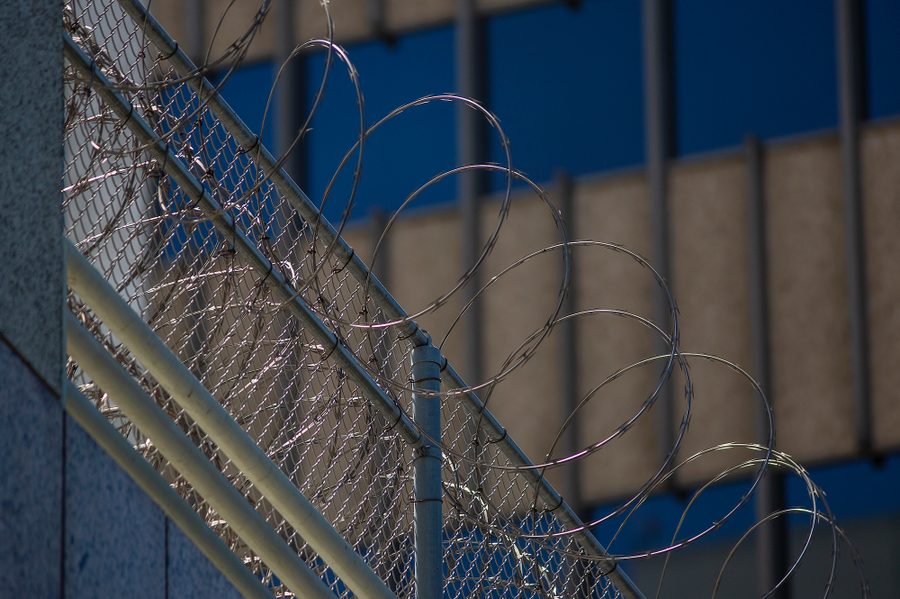"Someone Needs to Listen to Us": Why African Asylum Seekers Went On Hunger Strike
Inside a protest against racism at a Louisiana immigrant detention center.
Katie Jane Fernelius

PINE PRAIRIE, LA. — Forty-five African men, all seeking asylum, had been organizing for weeks at the Immigration and Customs Enforcement (ICE) Pine Prairie processing center in central Louisiana. On August 10, chicken was on the menu — which made it the perfect day to launch a hunger strike.
Many detained migrants at Pine Prairie generally avoid the cafeteria because the meals — usually bread, cabbage and beans — don’t inspire much of an appetite. But once a week, the cafeteria serves chicken — its most popular dish — and the chow hall gets crowded.
One by one, the migrants — hailing from Ghana, Kenya and Cameroon — marched into the hall and picked up their serving of chicken. They walked across the cafeteria and slid their untouched trays through the window to be discarded.
“We needed to create awareness to the facility that we were starting a hunger strike,” says Tekum, a Cameroonian migrant and hunger-strike organizer who has been detained since October 2019. (“Tekum” is an alias requested in fear of reprisal.)
According to interviews with multiple migrants at Pine Prairie, after dropping off their trays, the men left the cafeteria and entered a hallway where they sat on the floor or held their hands above their heads. Then, 15 guards entered with tear gas, pepper spray and handcuffs. With no additional provocation, the guards climbed on top of three of the migrants to put them in chokeholds.
“I was so frightful at the sight of the guards,” says Chi, also from Cameroon. “They were all dressed in riot gear with weapons and handcuffs and batons.”
“We are peaceful demonstrators,” Tekum says he pleaded. “We have committed no crime. Someone needs to listen to us!”
Two weeks later, officials placed all of the hunger strikers into Echo, a version of solitary confinement, where they remained for the duration of the strike. (ICE did not respond to a request for comment but has previously denied the hunger strike even happened.)
The August strike was the third hunger strike this year from African detainees at Pine Prairie — part of a concerted effort by the migrants to bring attention to their experiences of racism.
African migrants face unique challenges in ICE detention. Studies by the nonprofit Refugee and Immigrant Center for Education and Legal Services found that migrants from majority Black countries are sent to solitary confinement at a disproportionately high rate, pay higher bonds, and face more rejections for asylum than migrants from non-majority Black countries.
The African men at Pine Prairie have alleged in a complaint filed by the Southern Poverty Law Center that they are being indefinitely detained without parole and are the victims of racist treatment at the hands of ICE.
“These men at Pine Prairie know that they have to do backflips to get anyone to notice them,” says Sylvie Bello of the Cameroonian American Council.
According to Bello, Cameroonians make up the majority of African migrants detained by ICE. The Cameroonian military faces credible accusations of arresting people it identifies as dissidents, burning down civilian homes and killing citizens with impunity. But asylum is rarely granted to Cameroonian refugees.
“I came to this country looking for a safe haven, but it’s hell in here,” Chi says. “How much taxpayer money is being used to feed and house us when we could be out there contributing to society? We aren’t criminals.”
By early September, after intermittent conversations with ICE officials, all the migrants involved had ended their personal hunger strike. Many struggled with health issues and were warned they would be forcibly fed through a tube if they didn’t eat.
When Tekum was released from Echo, he realized the African migrants were now split into different units, making it more difficult to communicate.
Still, Tekum stays hopeful. Every night, he congregates with other Africans to pray. Often, they chain their hands together and sing worship songs. His favorite is “Ekwueme,” which translates from Igbo as, “The God Who Says and Does.”
Wearing a shirt he decorated with “Black Lives Matter,” Tekum sings the song a cappella over a video call, his eyes closed: “Ekwueme, Ekwueme. You are the living God, o! There is no one like you. You are a healer. You are my confidante. No one can touch me as you do.”
“This song sustained me through the hunger strike,” he explains. “It reminded me of my passion to fight for what is right.”
Addendum: Since this story was reported, Tekum and at least a dozen other Cameroonians were transferred out of Pine Prairie with short notice, in what their supporters say is likely retaliation.
Katie Jane Fernelius is a journalist and radio producer based in New Orleans.
Katie Jane Fernelius is a journalist and radio producer based in New Orleans.








